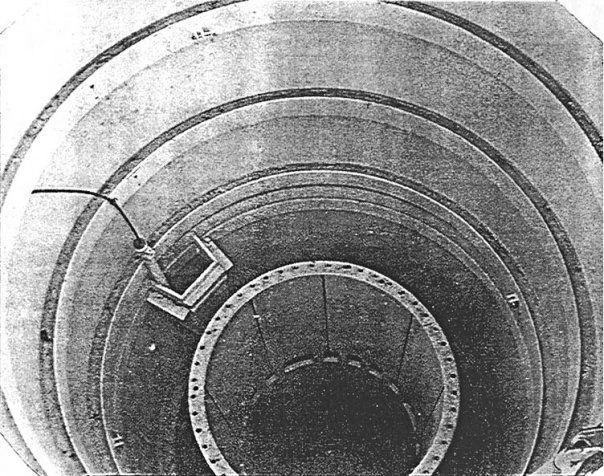Sharpner's Pond ABM Site
On November 3, 1967, the Dept of Defense publicly revealed the first 10 locations slated to receive the Sentinel Anti-Ballistic Missile (ABM) system designed to protect the continental US from ICBMs. Heading the list, Boston would host the first site. Throughout 1968, representatives from the Huntsville District and the local Army Corps of Engineers District teamed with members of the Army Air Defense Command (ARADCOM) to survey potential sites around Boston.
On August 16, 1968, DOD solicited Congress for acquisition of land near Sharpner’s Pond near Andover, MA for the huge Perimeter Acquisition Radar (PAR) facility and for a plot on a nearby National Guard facility for the Missile Site Radar (MSR). With Congressional approval granted in September, the Army implemented a three-phase construction plan. Learning from difficulties encountered with ICBM silo construction, Corps of Engineers and Department of Labor representatives met with local labor leaders to develop dispute-handling mechanisms. The Corps also incorporated a special road damage clause into the construction contracts to assuage local government officials concerned about highway maintenance.
By submitting a low bid of just over $767,000, George Brox Inc. of Dracut, Massachusetts, won the Phase I contract to construct the site access road, clear the site, and perform some excavation work. Once the Corps gave notice to proceed on September 24, Brox quickly commenced work. Phase II began on January 22, 1969, when Morrison-Knudsen Inc. of Boise, Idaho, was awarded a $2.2 million contract for preliminary construction work.
Initially, local reaction to the construction was subdued. However, with the upcoming national election, Sentinel sites became topics for debate, especially at the locations designated to receive them. With Sentinel construction actually under way near Boston, Ballistic Missile Defense opponents had a focal point to rally against. On January 29, 1969, the Corps hosted a public relations meeting at Reading High School. Despite a blizzard, over 1,000 people attended, including many local and out-of-state Ballistic Missile Defense, "BMD", opponents. The meeting received wide attention in the media as Huntsville Division’s Maj. Gen. Robert P. Young repeatedly was subjected to catcalls and hostile anti-BMD arguments.
The meeting sparked additional opposition efforts and the successful recruitment of Senator Edward Kennedy into the BMD opposition. The Senator’s January 31st letter to Defense Secretary Melvin Laird criticizing Sentinel ignited a congressional debate. On February 6, facing the threat of congressional cutoff of appropriations, Secretary Laird directed a program review. At a press conference on March 14, President Nixon announced the results of the review, which recommended a reorientation of BMD to protect ICBM bases. This new network became known as Safeguard.
The announcement of Safeguard spelled the death-knell for the Sharpner’s Pond site. With the announcement of the February 6th review, the Huntsville Division directed George Brox Inc. to limit operations to maintenance work. After the March 14 announcement, the Morrison-Knudsen contract was terminated and the Brox contract frozen.
Eventually, the site became the 8.5 acre Cyr Recreation Area, a park centered around the water-filled Perimeter Acquisition Radar excavation. It is located in the heavily-forested southeastern edge of town, near Sharpner's Pond Road and the Middleton border.
The proposed Essex Rail-Trail in North Andover follows the utility right of way near Sutton and Charles Streets going south through town by the High School, Steven's Pond, Lake Cochichewick, parallel to Salem street and ending at the border with Middleton on Sharpner's Pond Road. The Bay Circuit Trail continues East on Sharpners Pond Road to Boxford State Forest.
The Safeguard Anti Ballistic Missile System. This system was the replacement for the proposed Nike Zeus System. It was activated and deactivated in a matter of months due to the ABM Treaty.
Construction at the Sharpners Pond site never got much beyond excavating the cooling pond but the pictures below of the Safeguard Facility in N.D. will give you some idea of what would have been built if not for the signing of the A.B.M. treaty with the Russians.

Aerial View of the North Dakota Safeguard facility.

Giant radar.


Description of the various components.

Radar on left. Hardened air intakes and exhaust stacks for underground generator systems.


One of several missile fields.

When you see four layers of fencing, you know there's something interesting inside! The circular objects are silos
for the nuclear-tipped Spartan and Spring interceptors.

Close up of one set of generator intake and exhaust stacks.





Entrance to underground bunker.

Test launch of one of the interceptors.
Most likely not in N.D.

Looking down into one of the silos.

Missile being loaded into silo.

Missile in factory.

Model showing cut-away view of missile exhaust tunnel system and
personnel access.


Security checkpoint.

Extremely rare view inside the underground hardened facility.

Another inside view of a control room.

One of the faces of the radar antenna system.

"You can't fight in here . . . this is the war room!"

The Safeguard system had remote launch sites spread over a large area.


Diagram of the facility. The pond was used for cooling the equipment.

